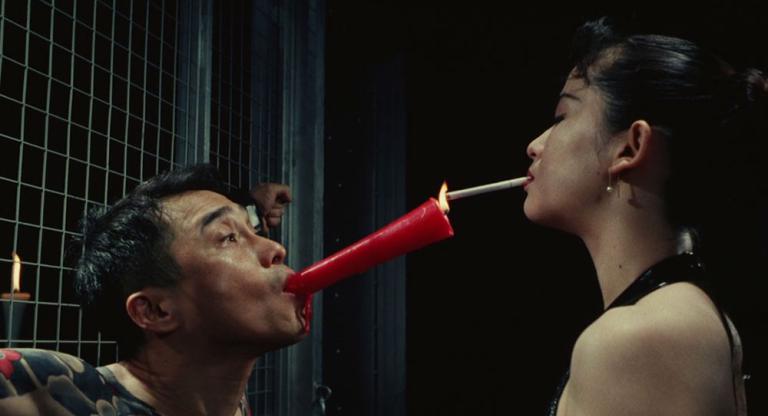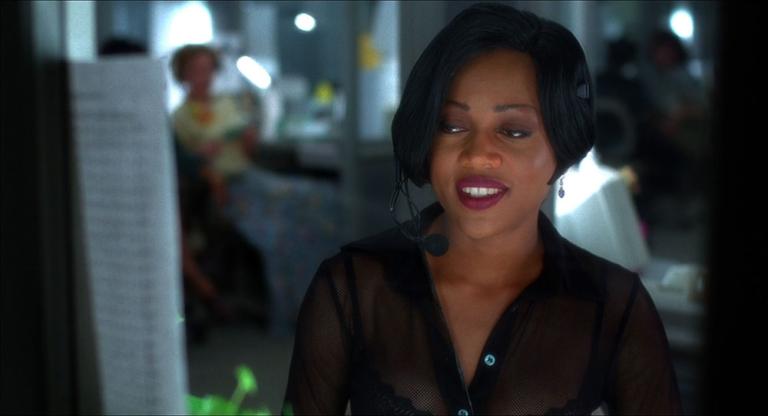This essay appears in “Women, Workers, & Whores on Film” Zine with the title “Macho Sluts.”
The director and dominatrix Cleo Übelmann leads us to her studio through a grey, wet, concrete pipe-laden hallway in her experimental film Mano Destra (1986). In this space, Übelmann’s female submissives become her art objects as they are arranged in cages, locked in cabinets, and tied up while we watch them squirm and feel time pass. The only break from this formal rhythm emerges at the midway point of the film, when Übelmann needs to complete administrative tasks related to book-keeping, framing her prints, and scheduling.
In his 1967 essay “Masochism: Coldness and Cruelty,” the philosopher Gilles Deleuze describes sadomasochism’s greatest principle as its ability to aestheticize time; in that liminal zone of feeling time is where pleasure or pain take root. Mano Destra can be, in this sense, understood as the filmic masochist embodiment of waiting. In some moments it appears that time has stopped altogether, and that Übelmann has sublimated a still image in the place of the moving one. Only in these extended sequences of stillness do we see a tremor in a thigh or heel, and realize that we are watching uneventful time move. In these sequences, Übelmann extends her domme persona to her role as director by ensnaring the audience in the movie theater just like she confines her submissives. Shot on black-and-white 16mm film, Mano Destra’s use of lighting and contrast allows her to play with the mood and tension of temporality as we see time pass through shadows and light that produce a more dramatic rendering of time than is possible with color film. Moreover, the dynamic 1980s synth-pop rock group The Vyllies’ infectious grooves provide a rhythm to the film’s depiction of waiting while also offering bolts of cacophonous disruption.
Mano Destra is a dynamic film in the queer canon that emerged at a time of intense contrition amongst feminists, known as the “sex wars.” Two camps emerged during this period, the pro-sex feminists and the anti-pornography feminists. The latter advocated against BDSM for they saw it as reproducing “violence against women,” and further argued that all pornography and sex work were rape. With Mano Destra emerging in this landscape, it is unsurprising—if not extremely disappointing—that it quite possibly fell victim to silencing in this climate as a film that is both about BDSM and sex work. Though it received mild renewed attention in the early 1990s when the scholar B. Ruby included the film as part of her seminal essay (and later book) “New Queer Cinema,” Mano Destra, like most experimental work by women media makers, largely disappeared due to lack of film distribution and exhibition opportunities.
Similarly, Kissy Suzuki Suck (1992) is a black-and-white video that resists mass appeal through its aggressively kinetic aesthetics and loose narrative depiction of two street-based sex workers. Shot on Betacam and inspired by Madonna music videos, Alison Murray’s experimental short, in which she also co-stars in, uses dance to propel the narrative action of two working girls waiting and contemplating the nature of the “trick” until they make out with one another, spit on themselves, and deliver comedic monologues about sucking cock. This all takes place as Coco Steel & Lovebomb’s “Feel it” plays.
Pairing the two films together allows us to see how different sex worker films approach time in relation to sexual labor. In Kissy Suzuki Suck, the working girls are lost in time, trying to remember what day it is, reminding themselves that it’s Tuesday. Ultimately, they end up back inside a car, sliding into the seats as the Betacam signal falls apart and colors rupture through the frame, signaling how their senses overwhelm their bodies and the film. This happens as they deliver separate stream of consciousness monologues about vomiting on dick and making money. Mano Destra turns the audiences into subs, forcing them to feel time and opening them up to the different dangers related to the types of pleasures and pains that become possible when you are forced to wait with your body. These works are not just dynamic contributions to experimental film and video, but to the histories of sex work on-screen. But, as the queer film writer Cherry Smyth writes in a 1992 essay for Sight and Sound titled “Trash Femme Cocktail,” both films were ignored for their aggressive female-led sexual queer depictions. Or, as Murray was quoted in that same article, for being too much of a “macho slut.” It is fair to say that given our current climate of sex-negative discourse, we as audiences should be seeking and learning from what macho sluts have to say about sex and labor.
Mano Destra and Kissy Suzuki Suck screen this evening, April 6, at Anthology Film Archives as part of the series “Women, Workers, and Whores on Film.”



